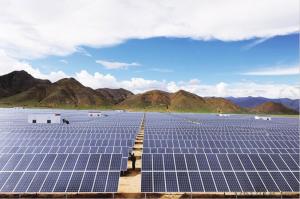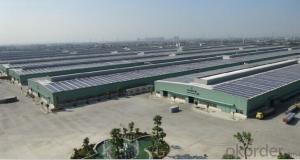Solar inverter CP500TL, 500kw for Solar Plant
- Loading Port:
- Shekou
- Payment Terms:
- TT OR LC
- Min Order Qty:
- 8 watt
- Supply Capability:
- 10000 watt/month
OKorder Service Pledge
OKorder Financial Service
You Might Also Like
Solar inverter CP500TL, 500kw for Solar Plant
Specifications
Low voltage ride through
Active power continuous adjustment (0-100%)
Reactive power adjustable, PF range 0.9lagging aa 0.9lead
Low voltage ride through
Active power continuous adjustment (0-100%)
Reactive power adjustable, PF range 0.9lagging – 0.9leading
Maximum conversion efficiency of 98.6%
Multi-language touch panel monitoring interface
Rigorous grid environment adaptable
Auxiliary electrical heating (optional)
High altitude application adaptable<6000m (power derating over 3000m)
Certificates and approvals including CE,CGC solar,BDEW etc.
Input Data (DC)
Max. DC power | 575KW |
Max. DC voltage | 1000V |
Full-load MPP-Voltage range | 450V – 820V |
Nominal input voltage | 500V |
Initial voltage/Initial power | 500V/5000W |
Max. input current | 1270A |
Number of MPP trackers | 1 |
Max. number of parallel strings | 16 |
Output Data (AC)
Nominal AC output power | 500KV |
Nominal AC output voltage | 270V |
AC output voltage range | 243V – 297V |
Nominal AC output frequency | 50Hz/60Hz |
AC output frequency range | 45Hz – 55Hz/55Hz – 65Hz |
Max. output current | 1200A |
PF (cosφ) | 0.9lagging – 0.9leading |
THDI | <3%(@pac,r)< p=""> |
Efficiency
Max. conversion efficiency | 98.6% |
Euro-eta | 98.3% |
MPPT efficiency | 99.9% |
Protection
DC disconnection device | yes |
AC disconnection device | yes |
DC Over-voltage protection | Arrester typeⅡ |
AC Over-voltage protection | Arrester typeⅡ |
Grid monitoring/regulation | yes/yes |
PV Isolation detection | yes |
General Data
Dimension (W/H/D) | 2000/2200/850 mm |
Weight | 2000kg |
Operating temperature range | -20°C … +50°C |
Humidity | 15% - 95% |
Protection level | IP20 |
Noise emission | 65dB(A)@1m |
Altitude | 3000m |
Standby power consumption | <100w< p=""> |
Cooling Concept | Forced Air Cooling |
Topology | Transformerless |
Display | LCD Touch Panel |
Communication interface | RS 485/ Ethernet |
Certificate & Approval
Approval | CE/CQC/TUV/BDEW |
- Q:What is the role of a solar inverter in power factor correction?
- The role of a solar inverter in power factor correction is to adjust the power factor of the solar power system to ensure efficient energy conversion. It helps in balancing the reactive power and real power, leading to improved overall power quality and reduced system losses.
- Q:Can a solar inverter be used with solar-powered water heaters?
- No, a solar inverter cannot be directly used with solar-powered water heaters. The solar inverter is designed to convert the DC power generated by solar panels into AC power for general electrical use in households. On the other hand, solar-powered water heaters utilize direct thermal energy from the sun to heat water, without involving the need for converting DC power to AC power.
- Q:How does a solar inverter prevent reverse current flow?
- A solar inverter prevents reverse current flow by using built-in diodes that act as one-way valves, allowing electricity to flow only in the desired direction from the solar panels to the grid or battery system.
- Q:How does shading affect the performance of a solar inverter?
- Shading can significantly impact the performance of a solar inverter as it reduces the amount of sunlight reaching the solar panels. This leads to lower energy production and decreased efficiency of the inverter. Shading can cause imbalances in the overall system, resulting in reduced power output and potential overheating of the inverter. Additionally, shading can lead to the activation of safety mechanisms within the inverter, such as Maximum Power Point Tracking (MPPT) algorithms, which further decrease its performance. Therefore, avoiding shading or implementing shading mitigation techniques is crucial for maximizing the performance of a solar inverter.
- Q:Can a solar inverter be used in systems with multiple solar arrays?
- Yes, a solar inverter can be used in systems with multiple solar arrays. In fact, it is common practice to connect multiple solar arrays to a single inverter, especially in larger solar installations. The inverter converts the DC power generated by the solar arrays into AC power that can be used by the electrical grid or consumed directly. By connecting multiple arrays to a single inverter, the overall system efficiency can be maximized, and it allows for easier monitoring and control of the entire solar power system.
- Q:Are there any government incentives available for solar inverters?
- Many countries provide government incentives for solar inverters, aiming to promote renewable energy adoption and reduce carbon emissions. In the United States, for example, one common incentive is the solar investment tax credit (ITC), allowing homeowners and businesses to deduct a portion of their solar installation costs from their federal taxes. Germany, on the other hand, implements feed-in tariffs that require utility companies to pay a premium for electricity generated by solar inverters. Furthermore, local governments may offer grants, rebates, or low-interest loans to facilitate the purchase and installation of solar inverters. To fully grasp the incentives available in your region, it is crucial to consult your local government or relevant authorities.
- Q:How does a solar inverter handle harmonic distortion?
- A solar inverter handles harmonic distortion by incorporating filters and control algorithms that help mitigate and minimize harmonics in the system. These filters are designed to reduce harmonic current injection into the grid, ensuring compliance with power quality standards. Additionally, advanced control algorithms continuously monitor the inverter's output waveform and adjust its operation to reduce harmonic distortion and maintain clean power generation from the solar panels.
- Q:What is the temperature range for optimal operation of a solar inverter?
- The temperature range for optimal operation of a solar inverter typically falls between 0°C (32°F) to 40°C (104°F).
- Q:Can a solar inverter be used with different types of grid support functions?
- Yes, a solar inverter can be used with different types of grid support functions. Solar inverters are designed to convert the direct current (DC) produced by solar panels into alternating current (AC) that can be fed into the electrical grid. They can be equipped with various grid support functions like reactive power control, voltage regulation, and frequency control. These functions enable solar inverters to adapt to different grid requirements and contribute to grid stability and reliability.
- Q:Can a solar inverter be used in parallel configurations for increased power output?
- Yes, a solar inverter can be used in parallel configurations to increase power output. By connecting multiple inverters in parallel, the total power output can be increased, allowing for more efficient utilization of the solar energy generated. This parallel configuration allows for better distribution of the power load and helps to achieve a higher overall system capacity.
1. Manufacturer Overview |
|
|---|---|
| Location | |
| Year Established | |
| Annual Output Value | |
| Main Markets | |
| Company Certifications | |
2. Manufacturer Certificates |
|
|---|---|
| a) Certification Name | |
| Range | |
| Reference | |
| Validity Period | |
3. Manufacturer Capability |
|
|---|---|
| a)Trade Capacity | |
| Nearest Port | |
| Export Percentage | |
| No.of Employees in Trade Department | |
| Language Spoken: | |
| b)Factory Information | |
| Factory Size: | |
| No. of Production Lines | |
| Contract Manufacturing | |
| Product Price Range | |
Send your message to us
Solar inverter CP500TL, 500kw for Solar Plant
- Loading Port:
- Shekou
- Payment Terms:
- TT OR LC
- Min Order Qty:
- 8 watt
- Supply Capability:
- 10000 watt/month
OKorder Service Pledge
OKorder Financial Service
Similar products
New products
Hot products
Hot Searches
Related keywords






























